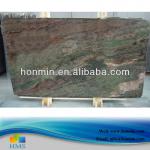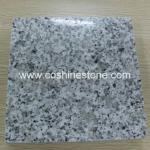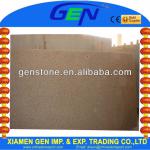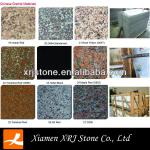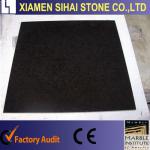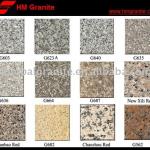Black Granite supplier
| Type: Granite | Place of Origin: Karnataka India | Brand Name: GANPATHI GRANITES | Color: Black |
| Surface Finishing: Polished | Granite Density (g / m³): > 3 | Stone Form: Block | Stone Name: Black |

Granite (pronounced ) is a common and widely occurring type of intrusive, felsic, igneous rock. Granites usually have a medium to coarse grained texture. Occasionally some individual crystals (phenocrysts) are larger than the groundmass in which case the texture is known as porphyritic. A granitic rock with a porphyritic texture is sometimes known as a porphyry. Granites can be pink to gray in color, depending on their chemistry and mineralogy. By definition, granite has a color index (i.e. the percentage of the rock made up of dark minerals) of less than 25%. Outcrops of granite tend to form tors, and rounded massifs. Granites sometimes occur in circular depressions surrounded by a range of hills, formed by the metamorphic aureole or hornfels.
Granite is nearly always massive (lacking internal structures), hard and tough, and therefore it has gained widespread use as a construction stone. The average density of granite is located between 2.65[1] and 2.75 g/cm3, its compressive strength usually lies above 200 MPa and its viscosity at standard temperature and pressure is 3-6 • 1019 Pa·s.[2]
The word granite comes from the Latin granum, a grain, in reference to the coarse-grained structure of such a crystalline rock.
Granitoid is used as a descriptive field term for general, light colored, coarse-grained igneous rocks for which a more specific name requires petrographic examination.[
Mineralogy
Orbicular granite near the town of Caldera, northern ChileGranite is classified according to the QAPF diagram for coarse grained plutonic rocks and is named according to the percentage of quartz, alkali feldspar (orthoclase, sanidine, or microcline) and plagioclase feldspar on the A-Q-P half of the diagram. True granite according to modern petrologic convention contains both plagioclase and alkali feldspars. When a granitoid is devoid or nearly devoid of plagioclase the rock is referred to as alkali granite. When a granitoid contains <10% orthoclase it is called tonalite; pyroxene and amphibole are common in tonalite. A granite containing both muscovite and biotite micas is called a binary or two-mica granite. Two-mica granites are typically high in potassium and low in plagioclase, and are usually S-type granites or A-type granites. The volcanic equivalent of plutonic granite is rhyolite. Granite has poor primary permeability but strong secondary permeability.
Chemical composition
A worldwide average of the chemical composition of granite, by weight percent:[4]
The Stawamus Chief is a granite monolith in British ColumbiaSiO2 — 72.04%
Al2O3 — 14.42%
K2O — 4.12%
Na2O — 3.69%
CaO — 1.82%
FeO — 1.68%
Fe2O3 — 1.22%
MgO — 0.71%
TiO2 — 0.30%
P2O5 — 0.12%
MnO — 0.05%
Occurrence
Granite is currently known only on Earth where it forms a major part of continental crust. Granite often occurs as relatively small, less than 100 km² stock masses (stocks) and in batholiths that are often associated with orogenic mountain ranges. Small dikes of granitic composition called aplites are often associated with the margins of granitic intrusions. In some locations very coarse-grained pegmatite masses occur with granite.
Granite has been intruded into the crust of the Earth during all geologic periods, although much of it is of Precambrian age. Granitic rock is widely distributed throughout the continental crust of the Earth and is the most abundant basement rock that underlies the relatively thin sedimentary veneer of the continents.
Origin
Granite is a common and widely occurring type of intrusive, felsic, igneous rock. Granites usually have a medium to coarse grained texture. Occasionally some individual crystals (phenocrysts) are larger than the groundmass in which case the texture is known as porphyritic. A granitic rock with a porphyritic texture is sometimes known as a porphyry. Granites can be pink to gray in color, depending on their chemistry and mineralogy. By definition, granite has a color index (i.e. the percentage of the rock made up of dark minerals) of less than 25%. Outcrops of granite tend to form tors, and rounded massifs. Granites sometimes occur in circular depressions surrounded by a range of hills, formed by the metamorphic aureole or hornfels.
Granite is nearly always massive (lacking internal structures), hard and tough, and therefore it has gained widespread use as a construction stone. The average density of granite is located between 2.65[1] and 2.75 g/cm3, its compressive strength usually lies above 200 MPa and its viscosity at standard temperature and pressure is 3-6 • 1019 Pa·s.[2]
The word granite comes from the Latin granum, a grain, in reference to the coarse-grained structure of such a crystalline rock.
Granitoid is used as a descriptive field term for general, light colored, coarse-grained igneous rocks for which a more specific name requires petrographic examination.[
Mineralogy
Orbicular granite near the town of Caldera, northern ChileGranite is classified according to the QAPF diagram for coarse grained plutonic rocks and is named according to the percentage of quartz, alkali feldspar (orthoclase, sanidine, or microcline) and plagioclase feldspar on the A-Q-P half of the diagram. True granite according to modern petrologic convention contains both plagioclase and alkali feldspars. When a granitoid is devoid or nearly devoid of plagioclase the rock is referred to as alkali granite. When a granitoid contains <10% orthoclase it is called tonalite; pyroxene and amphibole are common in tonalite. A granite containing both muscovite and biotite micas is called a binary or two-mica granite. Two-mica granites are typically high in potassium and low in plagioclase, and are usually S-type granites or A-type granites. The volcanic equivalent of plutonic granite is rhyolite. Granite has poor primary permeability but strong secondary permeability.
Chemical composition
A worldwide average of the chemical composition of granite, by weight percent:[4]
The Stawamus Chief is a granite monolith in British ColumbiaSiO2 — 72.04%
Al2O3 — 14.42%
K2O — 4.12%
Na2O — 3.69%
CaO — 1.82%
FeO — 1.68%
Fe2O3 — 1.22%
MgO — 0.71%
TiO2 — 0.30%
P2O5 — 0.12%
MnO — 0.05%
Occurrence
Granite is currently known only on Earth where it forms a major part of continental crust. Granite often occurs as relatively small, less than 100 km² stock masses (stocks) and in batholiths that are often associated with orogenic mountain ranges. Small dikes of granitic composition called aplites are often associated with the margins of granitic intrusions. In some locations very coarse-grained pegmatite masses occur with granite.
Granite has been intruded into the crust of the Earth during all geologic periods, although much of it is of Precambrian age. Granitic rock is widely distributed throughout the continental crust of the Earth and is the most abundant basement rock that underlies the relatively thin sedimentary veneer of the continents.
Origin-INDIA
| Packaging Detail:As per international standards |
| Delivery Detail:As per customer requirements |



